Lucky Sight (or how the Universe let me see my optical effect holy grail for a few seconds)
- By Lourdes B. Avilés, Ph.D.
- Aug 28, 2024
Before becoming Associate Provost at Plymouth State University, Lourdes B. Avilés, Ph.D., was a professor of meteorology for two decades, during which she taught a large number of courses, engaged in various topics of research, and wrote books on atmospheric phenomena.
Since my interest in atmospheric optics went from the mundane noticing of beautiful rainbows or puzzling about ice halos around the sun, to more scholarly interests for teaching and research purposes, I have been hoping to be in the right place at the right time to see some of the rarest of them all: antisolar halos. I am talking about ice crystal effects that are caused by the reflection and refraction of sunlight on the opposite side of the sun, in other words, the antisolar region of the sky. Since I became wiser about it, I have been taking a look on the opposite to the sun at any time when there are halos in the sky, but so far there has been nothing to see. Consistent with the rarity, there are only a small handful of pictures of such effects findable online.
Before I tell you my holy grail story, it is worth going over some of the basics. Clearly, sunlight makes it to us, and we have eyes that can see a variety of optical effects associated with that sunlight. We will, therefore, take those two important atmospheric optics ingredients for granted. The atmosphere of our planet is the third ingredient. Sunlight can be absorbed, transmitted, or redirected in a variety of ways (refracted and reflected, but also scattered in various directions, or simply bent a little bit) by the atmosphere itself and by the materials within. Exactly what happens depends on what materials in the atmosphere are affecting sunlight and how. Air molecules, dust particles, other aerosols and tiny droplets floating in the air, cloud and fog droplets, ice crystals, raindrops… they all can cause one or more effects. Some optical effects are quite hard to miss, right there in front of everyone’s eyes. Others are more subtle and easily missed if you don’t know what you are seeing, even if relatively common; and then, there are others reserved for those who are both lucky to be in the right place at the right time, but that also know enough to notice them and appreciate the treat that they are witnessing. My story below is of the last kind.
Ice Halos
Ice crystals floating in the air (either because they are in the clouds, or near the surface as so-called “diamond dust” (sometimes observed in extreme cold conditions) are excellent sources of atmospheric optical effects. The simplest of them is the 22° halo, a ring of light visible at a 22° angle from the sun. These halos can be very bright or quite faint, well-defined or diffuse, white or somewhat colored (reddish toward the inside), depending on the specific conditions, but always at exactly the same distance from the sun and circling a darkish center.
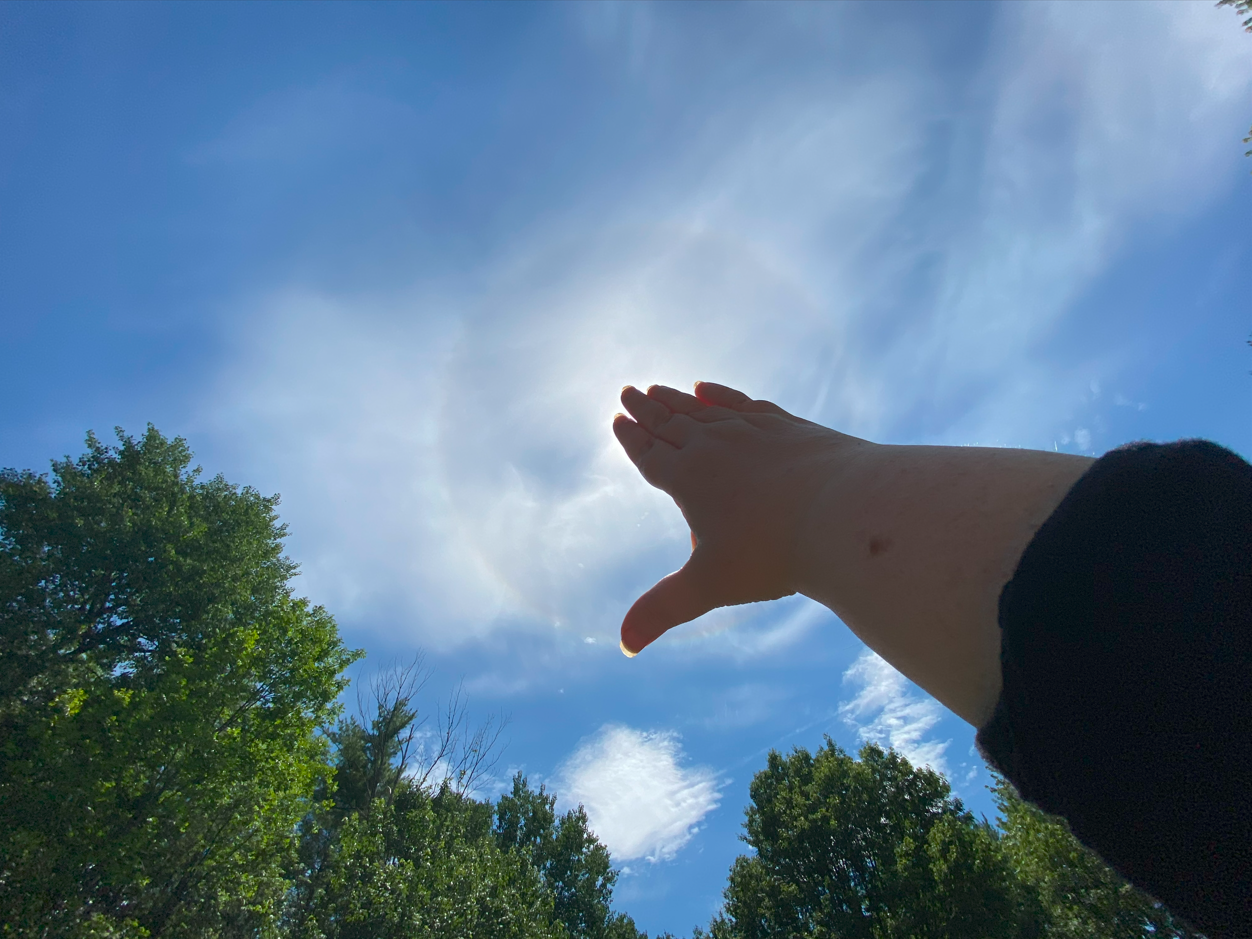
The 22° halo is relatively common and easy to identify. With your arm fully extended and using your hand to block the sun (which you should not look at directly), it is also easy to verify. The distance between the tip of your thumb and the tip of your pinkie finger with your hand fully extended is roughly 22° when your arm is also fully extended between your eyes and the sun. Another way to confirm a 22° distance can be done by, also with your arm extended, separating the thumb as much as possible from the rest of the fingers, putting the tip of your middle finger right at the position of the sun and the thumb will be roughly pointing somewhere along the circular halo (the method shown in this picture)
In my previous Weather Band Maestro article about the correct number of sides for scientifically accurate snowflakes, I described the different shapes of ice crystals, all of which have a six-sided symmetry in one way or another. It is interesting to note that the beautiful intricate dendritic snowflakes that motivated said article are not good for producing ice crystal optical effects. Simple three-dimensional hexagonal columns and plates are the shapes involved in the formation of all types of ice halos. The basic 22° halo, for example, forms due to the refraction of sunlight through randomly oriented hexagonal column crystals, as depicted in the hand-drawn diagram below.
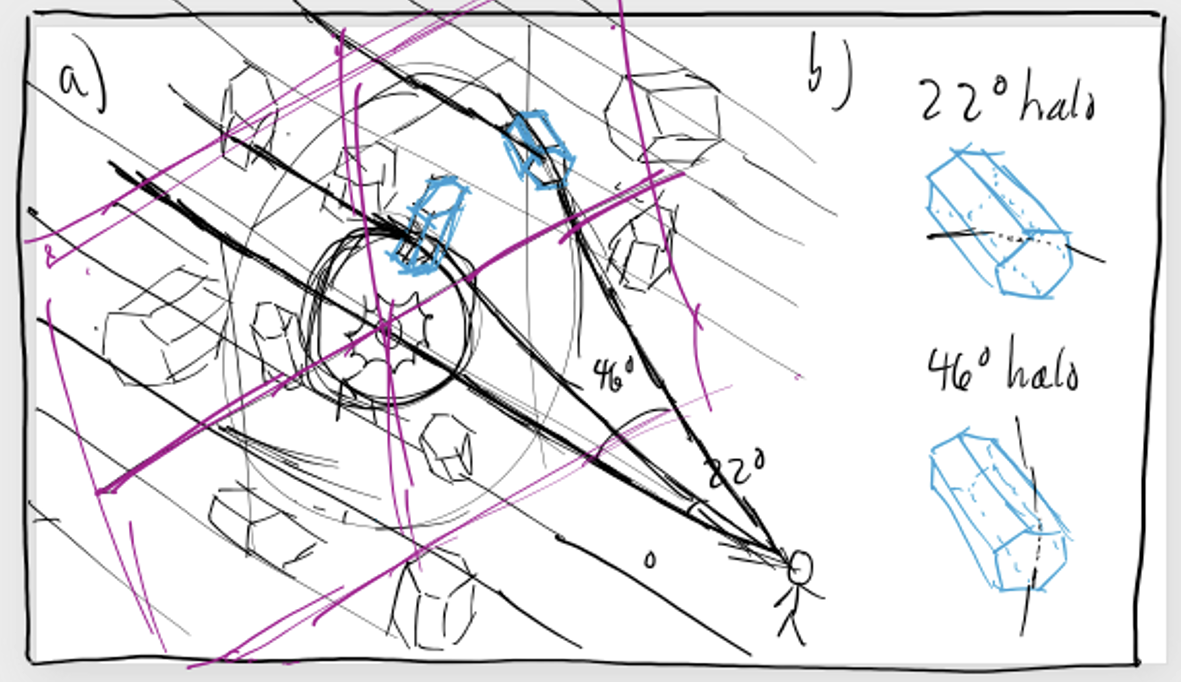
This diagram, which I put together when planning for textbook figures, shows the shapes, orientations, and path of light through ice crystals for the common 22° halo and the huge-in-the-sky, much fainter, and much rarer 46° halo. Because of the distance of the Sun, and the Earth being so small in comparison, rays of sunlight arrive to Earth parallel to each other. Randomly oriented hexagonal columns then send sunlight back to the observer’s eye in a way that looks like there is a light ring around the sun (a). For the 22° halo, the light has been refracted through two side faces of the ice crystal (at a 60° from each other), while for the 46° halo, light comes in a side face and off a flat “cap” of the crystal or vice versa (crossing two faces that are at 90° with each other)—as shown in (b). In order to see a full circular halo, ice crystals must be located in between the sun and the observer over the entire circumference of the visible halo.
The many possible combinations of crystal shapes, their orientation, their position in the sky, as well as the height of the sun when those conditions are present, can provide a wild variety of effects that sometimes show up on their own and sometimes together with a few or many others (in dazzling complex ice halo displays). They can manifest as spots, lines, arcs, or circles, and are sometimes due to refraction, or reflection, or a combination of both, depending on the specifics of the setup. A few of those are featured in this article, but it is perhaps a story for another time to discuss them in more detail.
A Long Day of Ice Halos
On 4 August, 2021, I received texts from two of my meteorology colleagues at Plymouth State University with pictures showing a couple of relatively infrequent halos. I was soon on my way to campus and started taking pictures from the moment I arrived. It took me about ten minutes just to walk from my parking spot to the adjacent science building (which normally took just a few seconds to a minute). These things usually go away quickly so I was excited that I made it on time to see anything. It never stopped, however, and the effects continued throughout the day. As the sun traveled across the sky and as different ice clouds moved through the field of view, what we could see evolved. We saw everything from a common diffuse 22° halo, to a very sharp colorful circumscribed version, to portions of a very sharp parhelic circle and a 120° parhelion and a very diffuse full parhelic circle very high in the sky, as well as upper tangent arcs and circumzenithal arcs. If we had a high vantage point, I am very sure we could have also seen a circumhorizon arc (see some picture examples of the days sights below). It is a good thing that classes had not started yet, because I spent most of the day on the roof deck (where many of the meteorology program’s weather-measuring instruments live), taking so many pictures that it was hard to sift through them afterward. It was even hard to go home at the end of the day. I thought I was finally done, and then I had to stop in front of Town Hall to take more pictures. Unlike the story below, I was indulged by a parade of ever-changing ice halos that lasted for hours and hours. Nothing like that has happened since that day.


If there are any optical effects in the sky, you can safely bet that I am taking pictures. This is a rare picture of me taking pictures during the day-long ice halo event on August 2021. This was an especially bright and colorful 22° halo, but it was also circumscribed, meaning that there was another effect superimposed. You can see a sign of the doubling of the side of the halo on the left side of the picture. The shape of circumscribed halos varies significantly depending on the height of the sun, as the diagram above shows. The sun must have been approximately 60° high during the time of the picture. I have been wanting to see that 40° bean shaped circumscribed halo for some time, but it would be very large in the sky, blocked or lacking ice crystals in the correct positions and orientations if one was even lucky enough to see the effect at the right time. When the upper and lower parts are split, they are called upper and lower tangent arcs, respectively, as shown in the 0°to 30° diagrams. I have seen several upper tangent arcs over the years, probably the most common version casually noticeable.
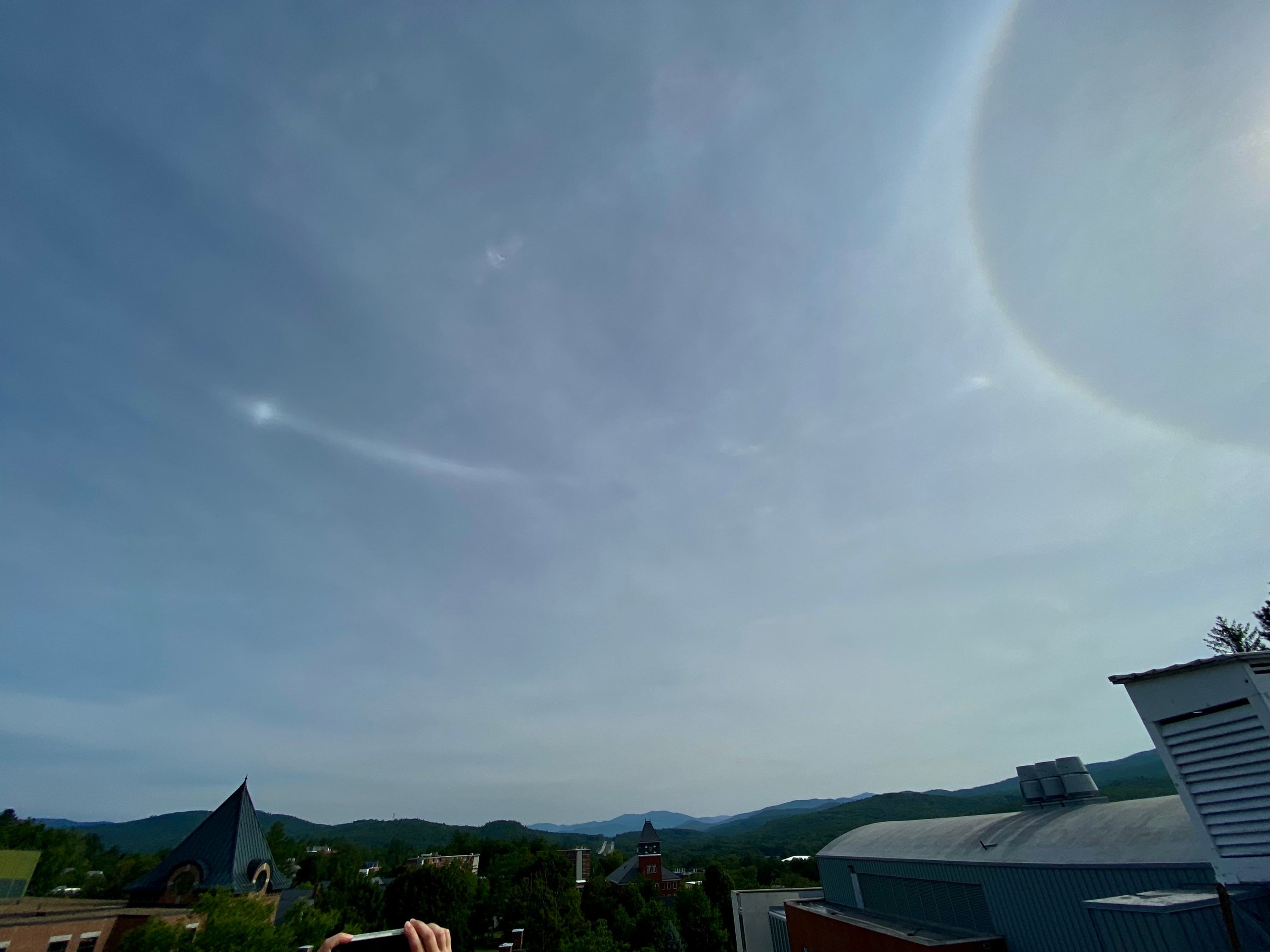
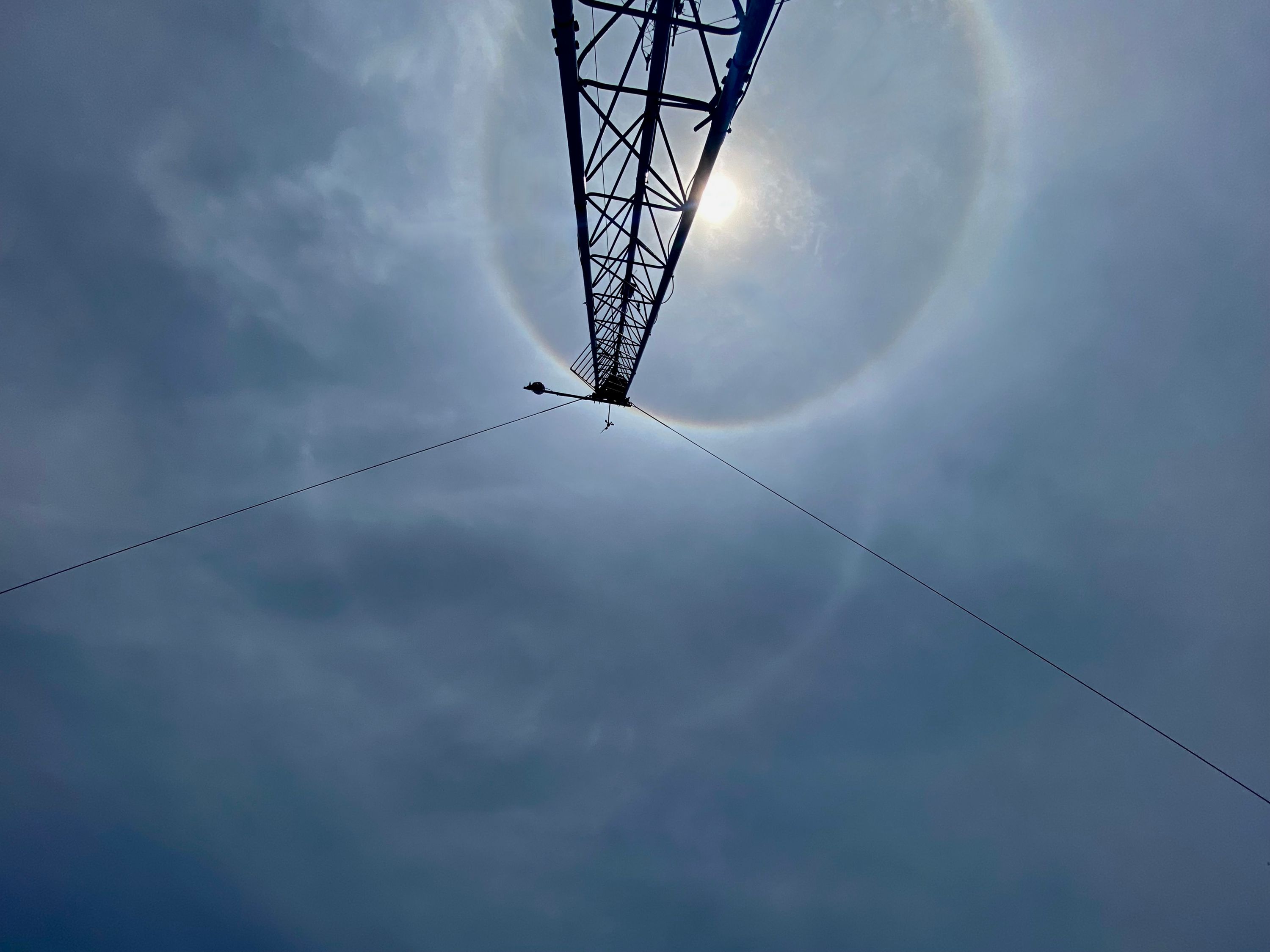
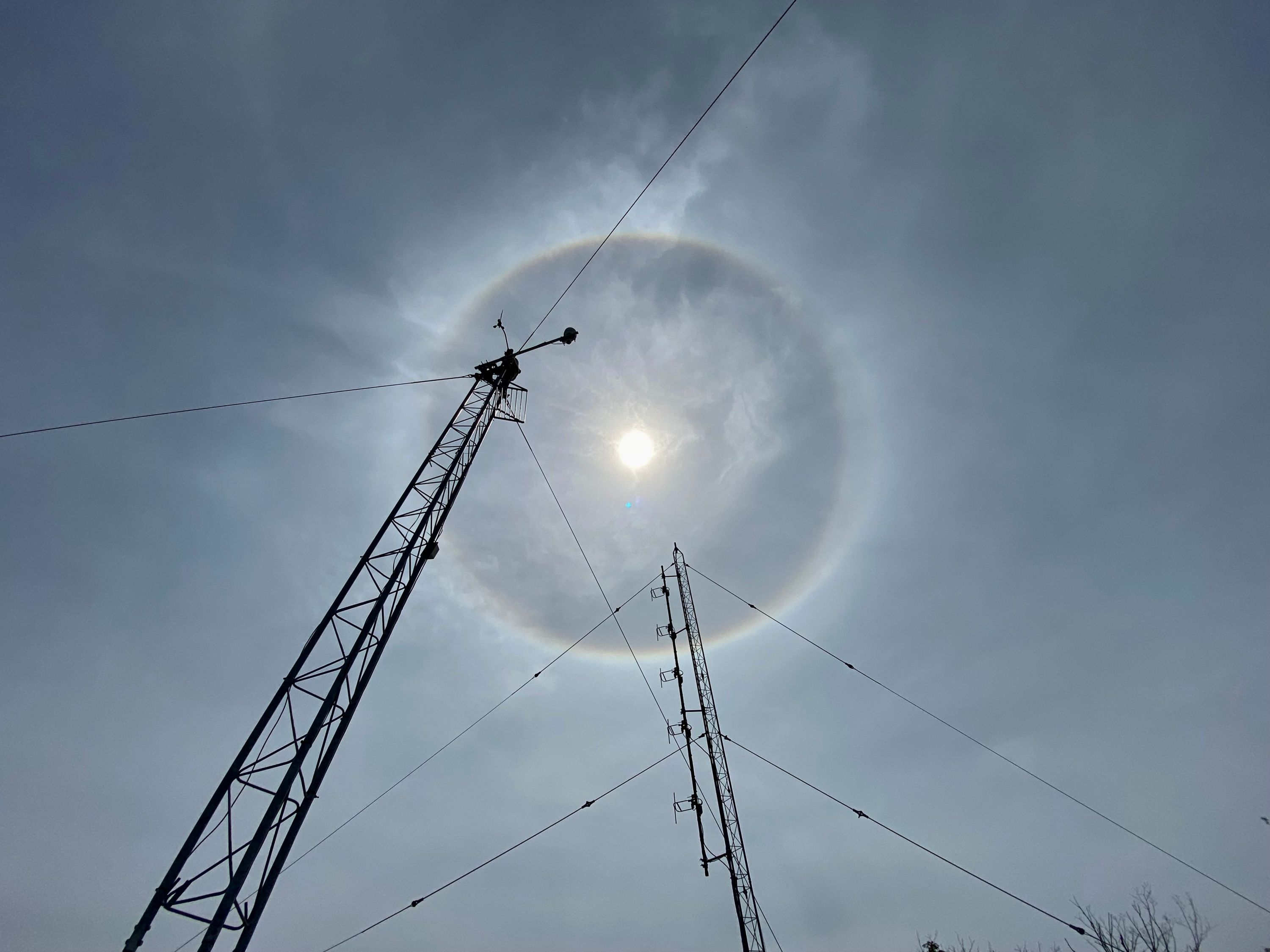
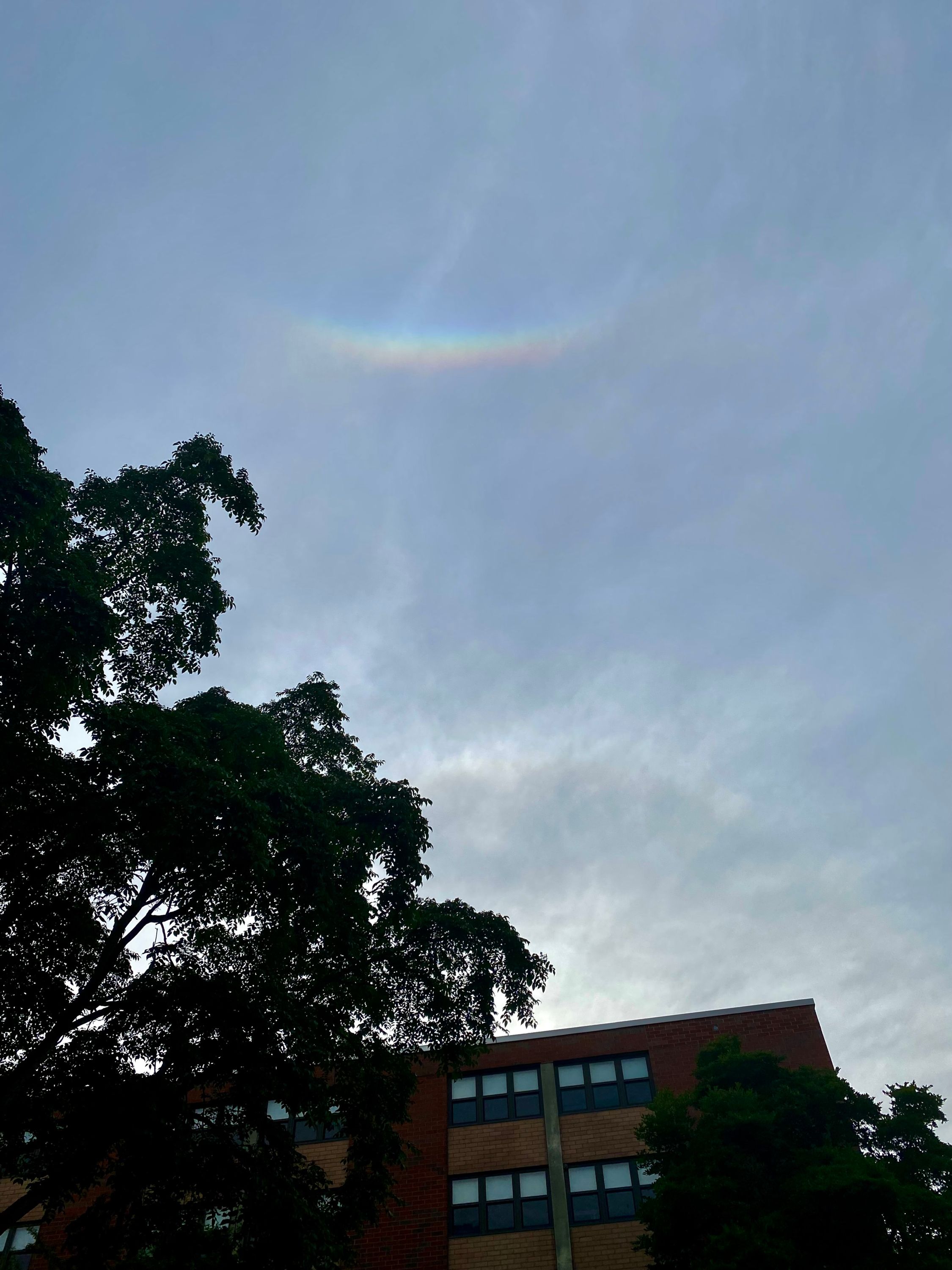

Early in the day we could see a sharp portion of a parhelic circle, a 120° parhelion (the brighter spot on the left of the first picture), and a faint parhelion (sundog) near a very sharp 22° halo. Sharp 22° halos like this one were visible for most of the day. The second picture, with the once again very bright 22° halo (and a hint of it being circumscribed) also shows a much fainter and somewhat broken parhelial circle with a radius similar to the 22° halo’s, coming out of the sun and more or less centered at the center of the picture. Parhelic circles become smaller and smaller as the sun is higher in the sky, but I had never had a chance to see anything like this, just little portions of low sun versions on a couple of occasions. The third picture is a clearer shot of the high sun and very bright circumscribed halo. Late in the day (next picture) the 22° halo was much fainter but a brightly colored circumzenithal arc (very high in the sky and circling the zenith) was clearly visible for a long time. The last picture shows the downtown shot in front of Town Hall that I had to take and for which I definitely did not park illegally.
A Brief Incredible Sight
When I fly, if I can help it, I purposefully choose the side of the plane with windows opposite to the sun for most of the flight. The possibilities for interesting optics are just much better. When flying over clouds made of water droplets, glories and cloud bows are possible if one has a view of the antisolar direction (exactly opposite to the sun) out the window. I have seen many glories and a few cloud bows in that way. Their explanation is a story for another day, as it can go into surprisingly complicated directions, but I am including a couple of pictures below, since they are so exciting to see. Most people do not notice the glories (and much less the cloud bows) when they are flying because they do not know that they are there, and never look in the appropriate direction—which is described below. Cloud droplets are spherical, so there are no shape or orientation restrictions on the glory like there are with most ice halo effects. The seldom-noticed glories are therefore easier to observe than specific halos, even the most common ones.


Glories and cloud bows can be observed when flying over clouds made of tiny water droplets—clouds are made of water droplets, ice crystals, or a combination of both, suspended in the air. If you determine the line from the sun, through your eyes and toward the water droplet clouds, that’s where the glory will be. An example is shown on the first picture. If close enough to the clouds, a shadow with the recognizable shape of a plane can be seen. The size of the shadow depends on how close the plane is flying to the clouds (larger if closer), but the size of the glory itself does not depend on that distance. The smaller cloud droplets produce larger glories, while the larger cloud droplets produce smaller glories regardless of how far away the clouds are. If the glory is very small, you might want to pay attention farther out to see if a cloud bow is present, as was the case on the second picture (the very small glory is to the left, and the very large circular arc that extends into the horizon is the cloud bow—which is akin to a fog bow but in the clouds instead of on the ground).
There I was, flying from Baltimore to Denver on Sunday, 4 February 2024. Being an afternoon flight roughly from east to west and in the winter, I chose to sit on the side of the plane that would be facing northward, so that I could catch anything that came up as the sun traveled across the sky, setting in the southwest direction. At first, we were flying through completely clear skies, meaning that there was nothing to see besides the pretty sights on the ground. I had plenty of work that I could do, so I focused on that, only once in a while distractedly looking out the window.
At some point I noticed that we were flying under a very high layer of cirrus (ice clouds), so now we had plenty of ice crystals, but we were not well positioned. To have a chance at seeing anything during the flight, we needed to be above the clouds with the sun shining on them. Oh well... With no water clouds below us either, I wasn’t really expecting to see anything. I did take a picture of the very high clouds above us, as clouds of all types and shapes are always interesting to me. I then went back to minding my business.

A layer of cirrus clouds is needed to have any chance of seeing ice halo effects when flying. One can guess the cloud layer in this picture might be made of ice because the base looks very smooth. The clouds, however, were blocking the sun, without which there is no possibility of seeing cloud optical effects. The fact that they were cirrus was verified later when the antisolar halos briefly appeared and it was also easier to see the wispy top of the cloud layer.
About fifteen minutes later, I noticed that the cloud layer was enveloping us rather than above us. I don’t think we went higher, but instead the base of the cloud layer became lower as we flew west. Still, there was nothing to see, since we were flying through a dense layer of cirrus. I continued working and casually looking out the window. It then all happened very fast, although I remember it in slow motion. When I looked out, we were high enough in the cloud layer that the sun was shining through, and I could see blue sky above. I then noticed a spot of light which quickly led my eye to noticing an arc extending to the right. And then, there they were, all the wonderful sights that I had been hoping to see for a long time: antisolar ice halos! I quickly grabbed my phone and fumbled to choose the camera app. I was thinking “hurry, hurry, OMG, OMG, don’t drop the phone, don’t mess it up!” Without taking any time to frame the scene or to find a better way to shoot at the very crooked angle at which I had a view, I took a picture. I only had time to take that ONE picture (shown below), and then it was all gone. I think the entire event from me noticing to the sight disappearing took about three seconds.

A rare vision of antisolar ice halos only lasted for a handful of seconds, during which I only had time to take one picture. The featured halos are described below.
Halos visible below the horizon are known as subhorizon arcs. They can be on the same side of the sun or the antisolar direction (much, much rarer). Over the years I have seen a few in the solar direction, for example, sub-parhelia (sub-sundogs), and a direct reflection of the sun called a subsun. The showstopper picture from February is both subhorizon and antisolar. It shows the faint shadow of the plane blocking part of the bright spot on the antisolar point, a subparhelic circle, and the X-shaped lines are likely the ends of the antisolar arc. A faint hint of diffuse arcs is visible above the antisolar point and inside the upper part of the antisolar arc’s X-shape. The horizon is tilted (due to the haste of the picture) and visible toward the upper half of the picture. A very faint hint of an above horizon parhelic circle and the anthelion (the patch of light opposite to the sun but at the same height in the sky) can be seen high in the picture within the blue sky. The diagram below identifies most of these features. In order for these arcs to be visible, sunlight must pass through well-aligned plate and/or column ice crystals in a variety of complicated path combinations of refraction and reflection (sometimes several instances of internal reflection within the ice crystals).
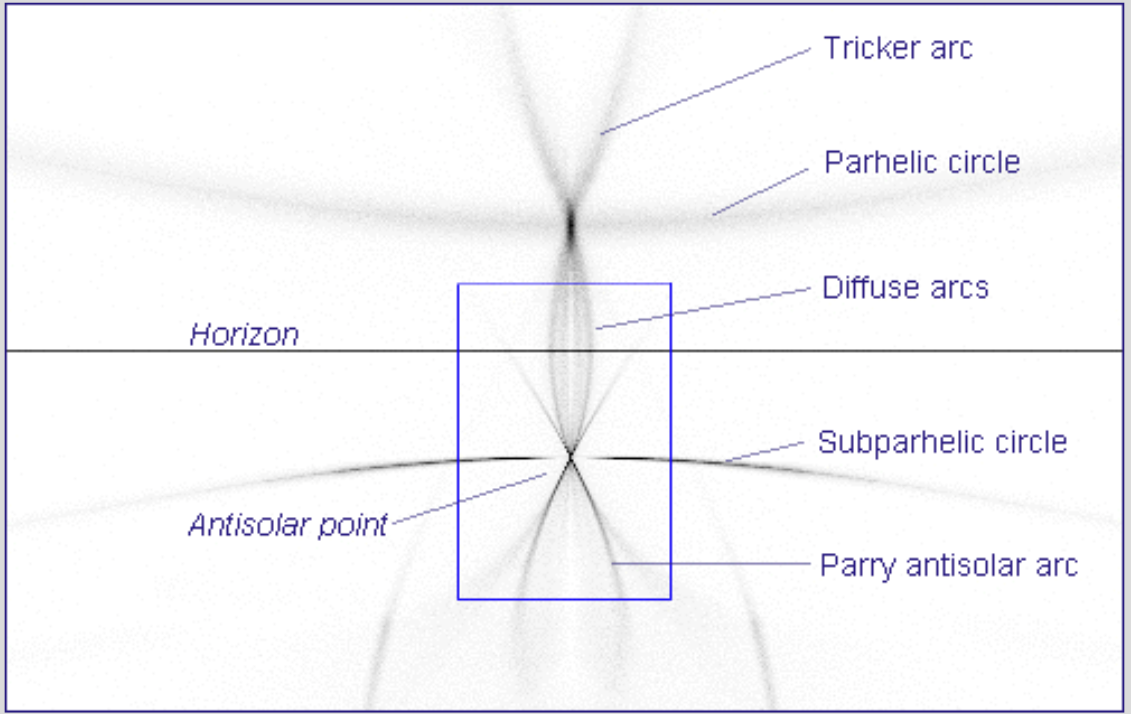
This simulation of ice halo effects on the opposite side of the sun was obtained from the old and famous among enthusiasts Atmospheric Optics UK website at https://old.atoptics.co.uk/halo/antisol.htm. The extremely useful reference site is not active anymore but for the time being maintains a web presence.
For the rest of the flight, I was not casually looking anymore; I had my nose right up to the window, hoping to see it all again and for a longer time than the brief sight, but it was not to be. At one point there was a faint hint that I could see only because I knew where to look, and even that quickly went away. The faint shadow of the plane continued to show me the direction where the action would be if it all came back, but the ice crystals were just not right anymore, either in shape or in orientation, or both… I will never know. During the trip back home, we were once again flying closely above ice crystal clouds (so no water droplet glories this time either) and again only the small shadow of the plane at the antisolar point was visible.
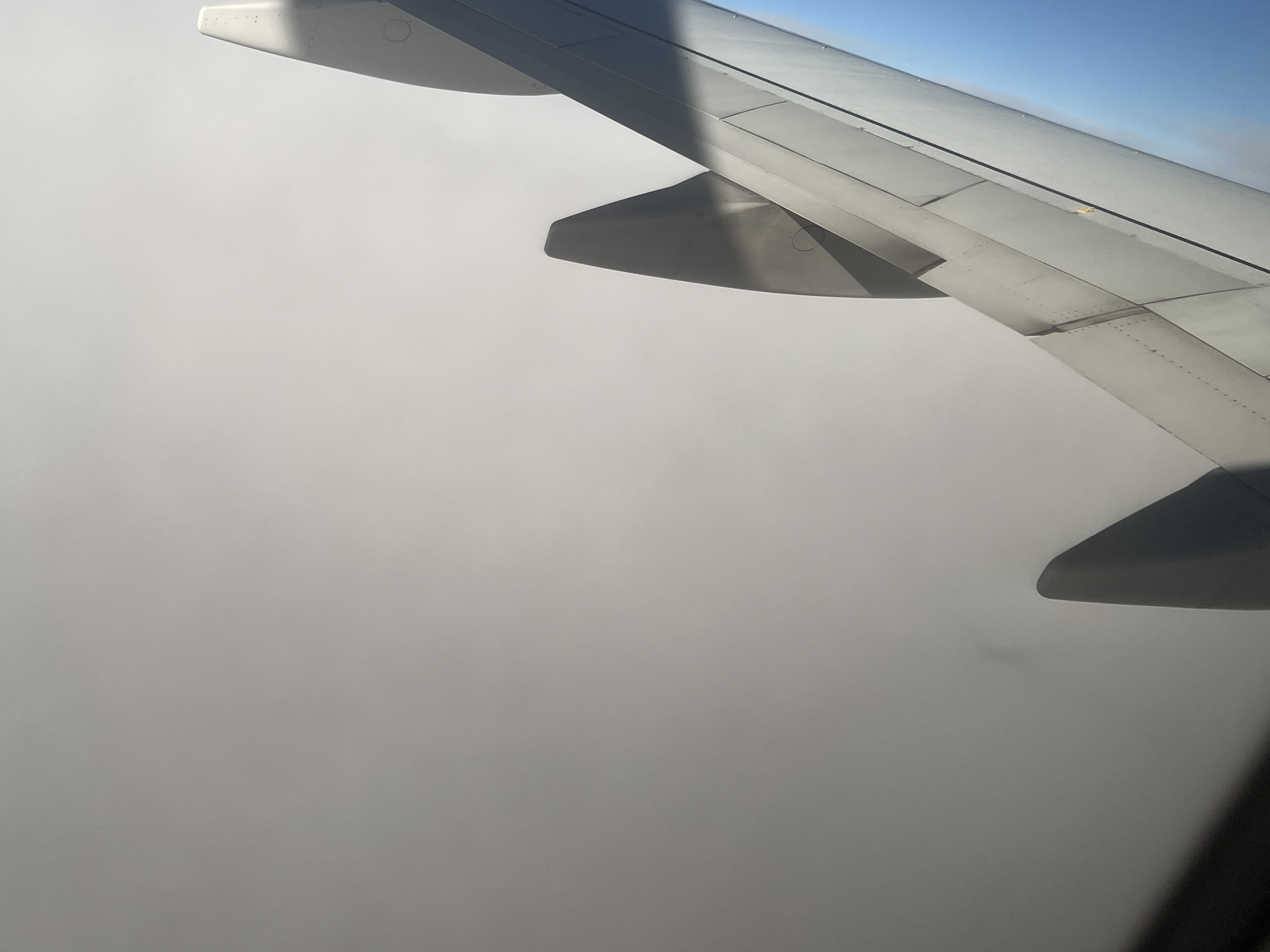
It is sometimes possible to see a faint shadow of the plane on the clouds (bottom right half of the picture near the wing). This is the location of the antisolar point. Here you can once again imagine a line from the sun, through your eyes and the shadow is located where that line extends into the clouds. This is the antisolar point and if the antisolar halos were going to be present, this is where they would center. If these were water clouds, this is where a glory would be visible. None of that was the case at this time.
Even though it all lasted a very short time, this was quite a thrilling experience. When we landed, I texted the picture to a few souls that could appreciate my excitement in one way or another and I posted it on social media. Work got busy and it took me a little time to look into the ice crystal shapes and other conditions that would cause the appearance of the elusive antisolar halos, but as soon as I started looking into it, the thrill was right back in full force.
